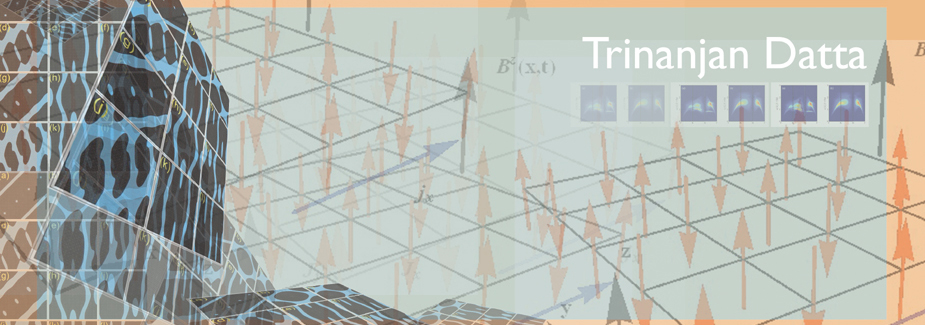| |
I am a theoretical condensed matter physicist specializing in magnetic systems. I primarily use theoretical and computational tools to investigate magnetic properties of magnetic models and compounds. I investigate spectroscopic (RIXS, Raman, INS, and transport) properties of magnon, multi-magnon, and topological magnon excitations in quantum magnets. I also work on classical Monte Carlo simulation of non-equilibrium behavior in magnetic systems.
Research Interests (Spectroscopy of correlated and frustrated magnets, topological quantum magnets, and non-equilibrium phenomena)
Periodicity staircase in a centrosymmetric Fe/Gd magnetic thin film system, npj Quantum Materials 9, 2 (2024)
 |
The presence of multiple competing periodicities may result in a system to go through states with modulated periodicities, an example of which is the self-similar staircase-like structure called the Devil’s Staircase. Herein we report on a novel staircase structure of domain periodicity in an amorphous and centrosymmetric Fe/Gd magnetic thin film system wherein the reciprocal space wavevector Q due to the ordered stripe domains does not evolve continuously, rather exhibits a staircase structure. Resonant X-ray scattering experiments show jumps in the periodicity of the stripe domains as a function of an external magnetic field. When resolved in components, the length-scale step change along Qx was found to be an integral multiple of a minimum step height of 7 nm, which resembles closely to the exchange length of the system. Modeling the magnetic texture in the Fe/Gd system as an achiral spin arrangement, we have been able to reproduce the steps in the magnetization using a Landau-Lifshitz spin dynamics calculation. Our results indicate that anisotropy and not the dipolar interaction is the dominant cause for the staircase pattern, thereby revealing the effect of achiral magnetism. |
RIXS in frustrated quantum magnets and correlated electron systems, npj Quantum Materials 5, 78 (2020)
 |
We study the resonant inelastic x-ray scattering (RIXS) features of vector chiral ordered kagome antiferromagnets. Utilizing a group theoretical formalism that respects lattice site symmetry, we calculated the L-edge magnon contribution for the vesignieite compound BaCu3V2O8(OH)2. We show that polarization dependence of the L-edge RIXS spectrum can be used to track magnon branches. We predict a non-zero L-edge signal in the non-cross pi-pi polarization channel. At the K-edge, we derived the two-site effective RIXS and Raman scattering operator for two-magnon excitation in vesignieite using the Shastry–Shraiman formalism. Our derivation considers spin-orbit coupling effects in virtual hopping processes. We find vector chiral correlation (four-spin) contribution that is proportional to the RIXS spectrum. Our scattering operator formalism can be applied to a host of non-collinear non-coplanar magnetic materials at both the L and K-edge. We demonstrate that vector chiral correlations can be accessed by RIXS experiments.
|
RIXS in frustrated quantum magnets and correlated electron systems, Physical Review B,89, 165103 (2014)
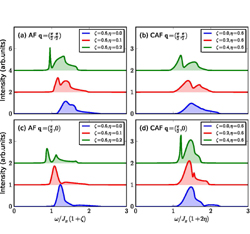 |
A comprehensive analysis of the bimagnon resonant inelastic x-ray scattering (RIXS) intensity spectra of the spatially frustrated Heisenberg model on a square lattice in both the antiferromagnetic and the collinear antiferromagnetic phase revealed RIXS spectrum splitting. Utilizing an interacting spin wave theory study within the ladder approximation Bethe-Salpeter scheme, we found the appearance of a robust two-peak structure over a wide range of the transferred momenta in both magnetically ordered phases. The unfrustrated model has a single-peak structure with a two-peak splitting originating due to spatial anisotropy and frustrated interactions. |
Einstein-de Haas effect of topological magnons, Phys. Rev. Research 3, 023248 (2021)
 |
We predict the existence of the Einstein-de Haas effect in topological magnon insulators. Temperature variation of angular momentum in the topological state shows a sign change behavior, akin to the low temperature thermal Hall conductance response. This manifests itself as a macroscopic mechanical rotation of the material hosting topological magnons. We show that an experimentally observable Einstein-de Haas effect can be measured in the square-octagon, the kagome, and the honeycomb lattices. Albeit, the effect is the strongest in the square-octagon lattice. We treat both the low and the high temperature phases using spin wave and Schwinger boson theory, respectively. We propose an experimental set up to detect our theoretical predictions. We suggest candidate square-octagon materials where our theory can be tested. |
Topological properties of multilayer magnon insulators, Phys. Rev. B 104, 064427 (2021)
 |
Two-dimensional magnetic insulators can be promising hosts for topological magnons. In this study, we show that ABC-stacked honeycomb lattice multilayers with alternating Dzyaloshinskii-Moriya interaction (DMI) reveal a rich topological magnon phase diagram. Based on our band-structure and Berry curvature calculations, we demonstrate jumps in the thermal Hall behavior that corroborate with topological phase transitions triggered by adjusting the DMI and interlayer coupling. We connect the phase diagram of generic multilayers to a bilayer and a trilayer system. We find an even-odd effect among the multilayers where the even layers show no jump in thermal Hall conductivity, but the odd layers do. We also observe the presence of topological proximity effect in our trilayer. Our results offer new schemes to manipulate Chern numbers and their measurable effects in topological magnonic systems. |
Neutron spectra of FCC Heisenberg magnets, Physical Review B, 85, 054409 (2012)
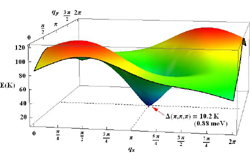 |
We studied the spin dynamics in a 3D quantum antiferromagnet on a face-centered cubic (FCC) lattice. The effects of magnetic field, single-ion anisotropy, and biquadratic interactions were investigated using linear spin wave theory with spins in a canted basis about the Type IIA FCC antiferromagnetic ground state structure which is known to be stable. We calculated the expected finite frequency neutron scattering intensity and give qualitative criteria for typical FCC materials MnO and CoO. The magnetization reduction due to quantum zero point fluctuations was also analyzed. |
Non-equilibrium Monte Carlo simulation of the XY model, Phys. Rev. E 110, 054109 (2024)
 |
The classical 2DXY model is known to support topological excitations known as vortices. In spite of the Mermin-Wagner-Hohenberg theorem a phase transition related to the binding-unbinding of vortex-antivortex pairs occur at the Berezenskii-Kosterlitz-Thouless transition temperature. However, a static magnetic field applied along the plane modifies the vortex-antivortex interaction and promotes three distinct vortex phases - a linearly confined phase, a logarithmically confined phase, and a free vortex phase. Additionally, a renormalization group analysis combined with duality in the model shows that at high temperature and high field, the vortices unbind as the magnetic field is lowered in a two-step process. First, strings of overturned spins proliferate. Second, vortices unbind. The transitions are continuous but are not of the Kosterlitz–Thouless type. Thus, it may be natural to ask what happens to the excitations of the equilibrium model when it is exposed to an oscillating magnetic field. In a recently published Phys. Rev. E article, my collaborators and I used classical Monte Carlo simulation and a mean-field approach to show that the 2DXY model with an oscillating field can support three stable dynamical phases. Finite size scaling analysis suggests that the transitions between the dynamical phases either belong to the 2D Ising universality class or are first-order in nature.. |
Series Expansion of the 1/5-th depleted Ising model, Physical Review E,87, 062143 (2013)
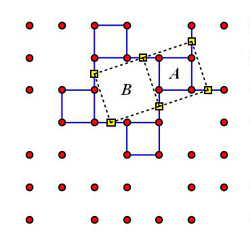 |
We studied the spin dynamics in a 3D quantum antiferromagnet on a face-centered cubic (FCC) lattice. The effects of magnetic field, single-ion anisotropy, and biquadratic interactions were investigated using linear spin wave theory with spins in a canted basis about the Type IIA FCC antiferromagnetic ground state structure which is known to be stable. We calculated the expected finite frequency neutron scattering intensity and give qualitative criteria for typical FCC materials MnO and CoO. The magnetization reduction due to quantum zero point fluctuations was also analyzed. |
Past Research Interest
Quantum wires, Luttinger liquids
1D FFLO state without time reversal symmetry breaking in quantum wire, Eur. Phys. J. B 67, 197--208 (2009)
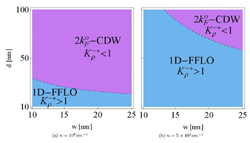 |
A novel route to a one-dimensional Fulde-Ferrell-Larkin-Ovchinnikov (1D-FFLO) state in the absence of broken time-reversal symmetry was proposed in this paper. At present such a state may be encouraged in a clean AlAs quantum wire. Using the AlAs quantum wire as an example it was shown using bosonization and the renormalization group approach that the 1D-FFLO state can arise due to a combination of Coulomb interactions and the unique bandstructure arrangement of the AlAs quantum wire. The present theoretical proposal is very general and is applicable to other systems with similar fermionic interaction terms. |
|
|
